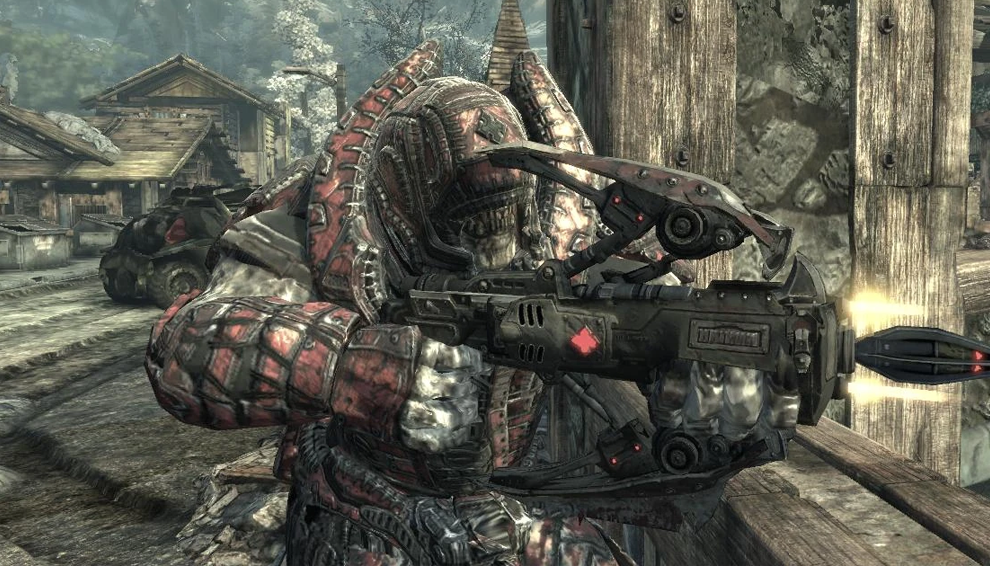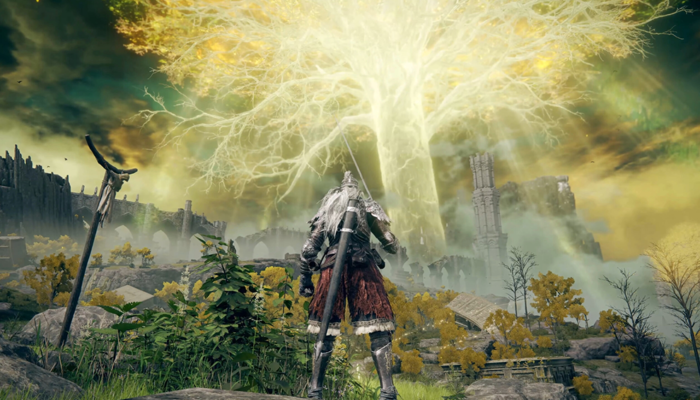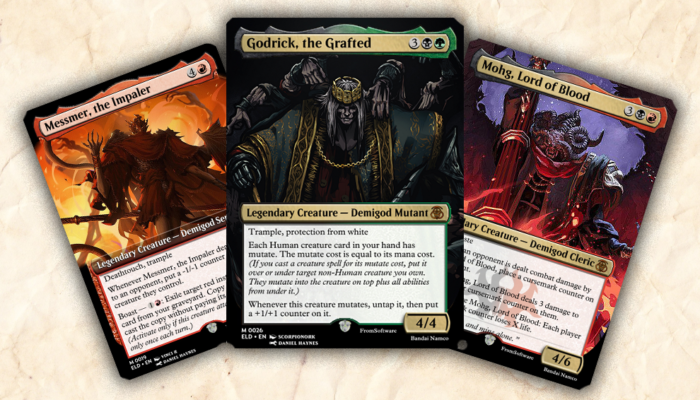Whilst I was designing the fighter’s kits for the new Fatal Knockout expansion, I got thinking about how weapon designs during the Xbox 360 era were so instantly iconic and memorable. Everyone knows Halo’s Plasma Grenade and the Chainsaw Lancer from Gears of War, but why? I had a think about this and found a pretty common through line with their designs.
Later in the blog I will explain how this analysis helped me design one of the newest fighters in my board game Fatal Knockout!
Case Study #1: Torque Bow

The Torque Bow is a “power weapon” first introduced in the first Gears of War, it is wielded in the story by powerful elite enemies and found in rare spawn locations in multiplayer. It works like this: Charge it up slowly to begin straightening its arc, piercing power, and speed whilst a haunting, mechanical sound builds in intensity, at the end of which an explosive bolt is released at lightspeed. It strikes into a surface (hopefully an enemy), sticking, then exploding for a potential instant kill. This is a perfect weapon in a horror cover-shooter because when you hear the noise of someone winding up one of these, you know to immediately dive for cover as to not risk getting blown into giblets immediately. It puts a ton of value on remaining in cover, sowing that seed of fear into the opponent’s mind, further reinforcing the central cover mechanic. The fact that you could be doing fine one second, only to be stuck with a bolt and explode the next is quite terrifying, so it has a tangible mental effect on people. You should see how the enemy team react when you start charging up this weapon in front of them in multiplayer. It has a seriously dominating presence!
The wind-up of the weapon, its horrifying sound, the payoff, and its ability to scare the enemy into cover to avoid its devastating wrath (especially against players online!) is a masterful use of tension/release.
Case Study #2: Chainsaw Lancer
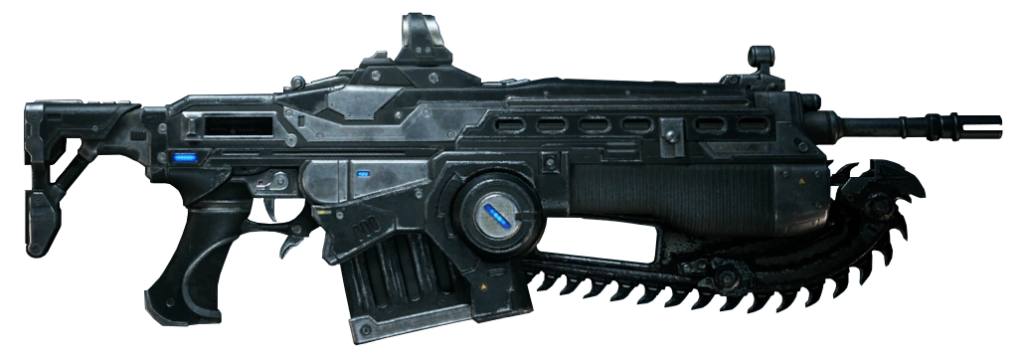
Another weapon from Gears of War… the Lancer! One of the most iconic weapons in gaming. But why? The standard fire mode of this weapon is fairly run of the mill and doesn’t create much tension; A steady spray of bullets that’s main purpose is to lock down enemies. The alternate function of the weapon, however, the underslung chainsaw, is the part I’m going to be commenting on. How it works is; whilst the Lancer is equipped, you hold a button to rev up the chainsaw whilst walking around with tank controls. If you bump headfirst into an enemy during this state you enter a gory animation where you saw them to pieces for an instant kill. Just like the Torque Bow, this part of the weapon features a terrifying sound effect when winding it up, giving it a real fear factor just like the former. The volatile nature of it instantly killing an enemy creates a real sense of dread on the battlefield. It quite literally recontextualises how you perceive dark corners/hiding spots. There might just be a scary monster waiting to murder you horribly!
These weapons being standard issue (common in single player and part of the core loadout in multiplayer) makes the probability of someone sneaking up behind you with a chainsaw very high. There is tension here in not only the subconscious layer of knowing that most people have the capacity to sneak up and get you, but the fight or flight scenario itself of scrambling to dive away and shoot to stagger the opponent before they catch you.
Gears of War also benefits from its weapon designs in a uniquely emotional way because of the game’s over-the-top gory presentation. The simple fear of not wanting to see your character get torn apart in horrible ways creates a sense of tension and dread in the effort to avoid these weapons; an idea I don’t really hear people talk about often! You know, that same disturbing feeling you got when you saw Leon get dismembered in Resident Evil 4 for the first time. If you know, you know!
Case Study #3: Plasma Grenade
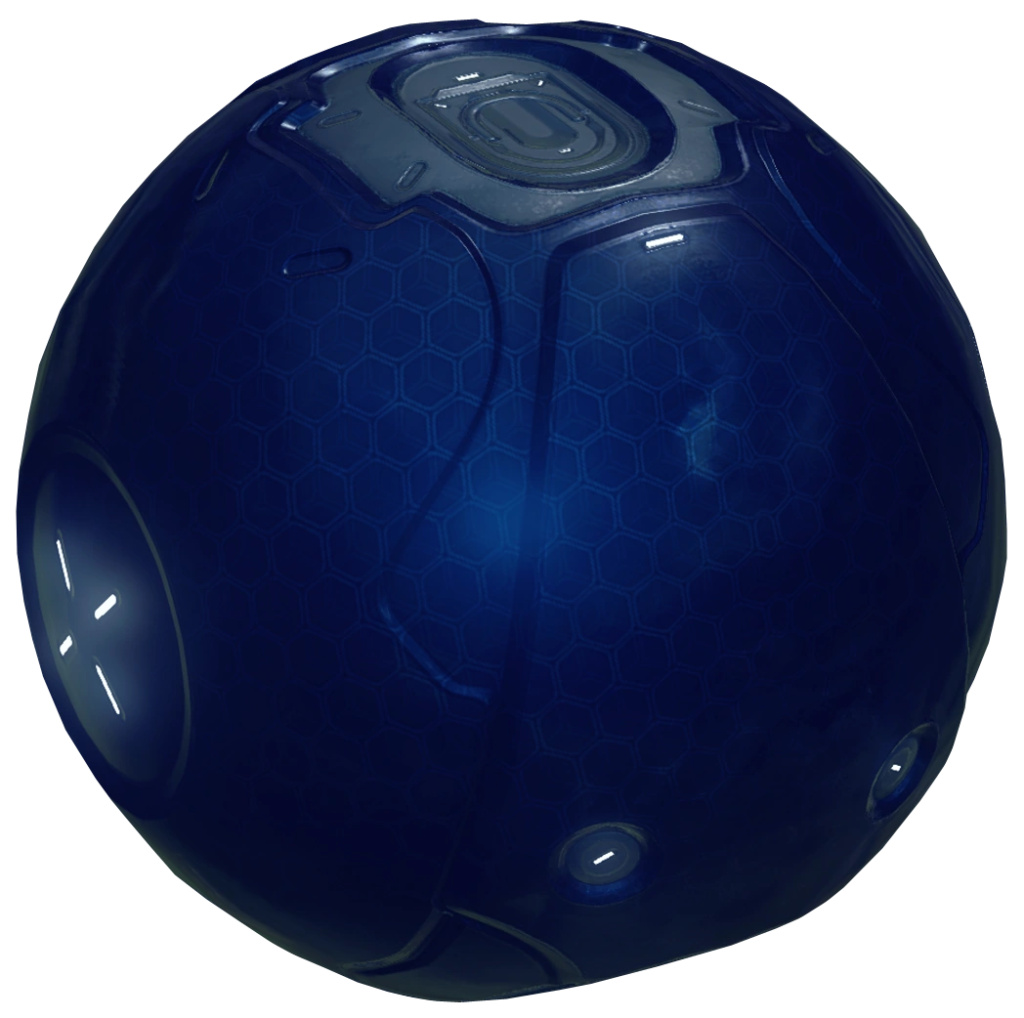
Now, out of the realm of horror and onto the Halo series. The Plasma Grenade I would argue is the most iconic throwable in the franchise. A sticky bomb that attaches to an enemy with no hope of removing it, before it begins glowing intensely blue along with a ramping high pitched sound effect followed by a huge explosion of plasma. It is powerful enough to instantly kill any normal enemy. Some select enemies can throw these at you in singleplayer, but more commonly people will wield these in multiplayer as a core part of the combat. Simply having a Plasma Grenade always feels valuable because of the amount of impact it can have in such a short time. Stick someone with one and you get a guaranteed kill or perhaps multiple if people are tightly grouped together. This also breaks up the general ebb and flow of Halo combat which is mostly consists of gunning people down on sight and meleeing if they come in range. If you managed to get any grenade off to weaken an enemy before an engagement it is extremely valuable, no doubt. However, the Plasma Grenade can kill outright which makes its very fearsome. This adds some fun tension/release to combat. It doesn’t add a horror factor like in Gears of War since that’s clearly not a part of Halo’s identity, it is more about breaking up the flow of combat and introducing exciting moments of anticipation waiting for the enemy to explode and goes flying in a blaze of glory.
Case Study #4: Spartan Laser

The Spartan Laser. A classic “power weapon” introduced first in Halo 3. A big bulky laser cannon that requires a sustained input to charge a devastating beam that can instantly kill any enemy and most vehicles in one hit. The function is fairly simple and effective. A long build up and charge followed by a devastating payoff if landed properly. Using it on a standard enemy is a good use, but the biggest payoff is hitting a vehicle full of enemies with it which is where its power lies. The tempting knowledge that you could cause said devastation when you pick this thing up is why there is a tangible fear factor seeing someone charge this up on the battlefield. It also provides a nice anti-vehicle solution that gives the wielder a huge emotional payoff.
The effective use of tension is mainly in the overly long buildup of its charge (just like the Torque Bow!), the main purpose of which is to sell the devastating effect of the beam. That, combined with the spectacle of the visuals and the destruction it causes is designed to provide the wielder with a brief emotional high. You will see this trend quite often with “power weapons” in these style of games because they are designed to mix up the normal power dynamic between combatants in a level.
What they all have in common
Each of these weapons all seem to have a common through line. A build-up.
Whether that is from charging the weapon to full power, or its the anticipation of a grenade eventually going off, each of these weapons have some form of build-up.
Build-up creates anticipation that naturally expects a form of satisfying release, which is why it’s so effective in selling the power of something. Just like you would have to wind back your arm to unleash a strong punch, there is a natural expectation in the player’s mind when seeing something taking a while to charge up – because it must be building up energy for a reason! This is doubly true when the player is holding the source of it in their hands, like with a weapon. They yearn to see the satisfying payoff.
For Gears of War, this works very well with its themes of horror, as great anticipation is a recipe for great scares. It also creates unease and fear of what these weapons of destruction might do to you, the player character.
But why bother designing things this way? I believe effective use of tension is brilliant in engaging the player in a moment of gameplay. Setting up tension is like setting up a promise in the player’s mind, one that will definitely be fulfilled in some way. There are many ways to introduce this into a game. Weapons, systems, music, sound, narrative, pacing, etc. Though, for a weapon specifically I think it can be used very well in evoking emotions of power or fear through anticipation. You can’t just create big moments, they have to be earned. Tension is a way to justify those big moments.
Applying these ideas in Fatal Knockout

I took these thoughts into account when designing a new fighter in my board game, Fatal Knockout.
First of all, I was brainstorming novel archetypes for potential expansion fighters that had not yet seen the spotlight in the roster. Already in the base game we have had big body grapplers, super fast speedsters, technical puppeteers and the lot. We already filled the boots of many established fighting game archetypes so we were in a good spot. It also gave me a reason to go off the beaten path for what players expect and make something that subverts the design philosophies players will be familiar with up to this point.
I’ve always loved the idea of overwhelming tension married with horror. A huge build-up to something terrifying. Great horror movies do this and it was a big source of inspiration for the idea I’d eventually come up with: “The Maniac”.
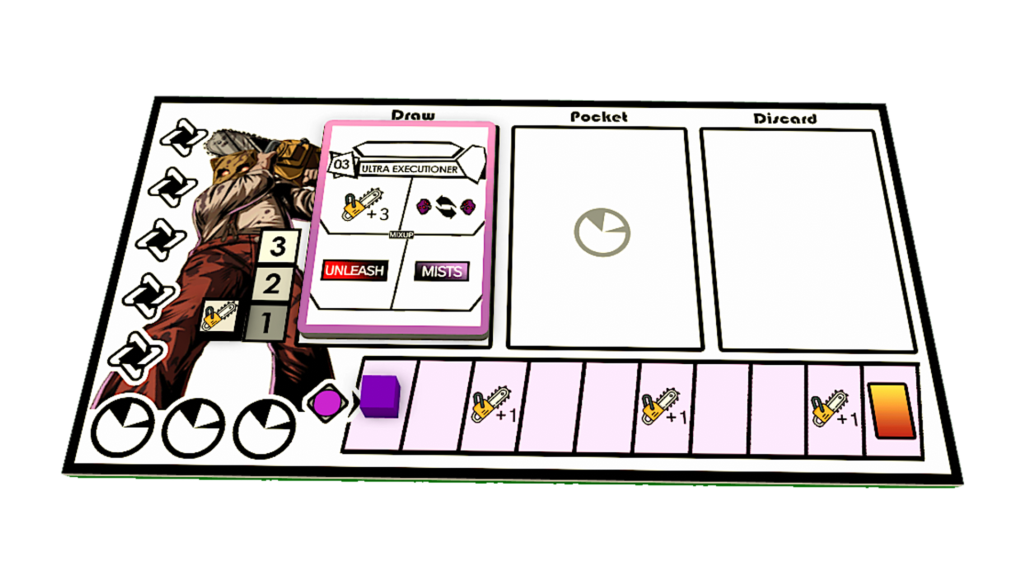
It started as an idea in my head: A Jason Vorhees style killer trudging around the board with an immense presence and the ability to perform terrifying plays – a fighter design that you would not want to go anywhere near! I wanted to design this fighter to fulfil a player fantasy of being a scary killer in a slasher movie (something easily understood by its playstyle and art), have strong mechanics that evoke a feeling of power in the player and fear in the opponent respectively, and feel like they still fit in amongst the existing roster. A fighter who is truly volatile and fearsome in appearance and playstyle.
I knew I had to evoke some form of fear through design. But… what scares people in the context of Fatal Knockout? What is strong? What causes players to feel cornered? What creates good tension?
The answer was… big damage!
It sounds simple, but Fatal Knockout players have always had one major game plan when playing: Defeat the opponent! Through many previous playtests I’ve found that it is mainly two mechanics that change the way someone makes a decision: how they can achieve the highest damage / take the lowest damage, and if not, how to maximise energy gain to set up future plays (that result in later damage).
Knowing this, I wanted to play with the idea of “unlocking damage potential” in the Maniac’s design – a use of effective build-up that the opponent would dread to see the full effect of.
Inspired by Arc System Works fighting games such as Blazblue, I wanted to take inspiration by how they constantly design exceptions to their own established system mechanics with each character’s kit. An avenue not yet explored by Fatal Knockout. For example, a certain character having their own special health bar, or a certain character being able to steal super meter from their opponent.
This train of thought eventually led to the development of the Maniac’s “Fear Track”, a unique subversion of Fatal Knockout’s standard Meter Track (a timeline that progresses when using moves that have energy symbols, unlocking various goodies and eventually a super move at the end). The Fear Track would be a direct replacement that would have the Maniac gain meter through a different method which seems more in line with the player fantasy I wanted to nurture:
He gains meter by being close to the opponent.
This choice was simple to understand and made being constantly on top of the opponent rewarding, which then in turn scares the enemy with your ever increasing strength. They have to now make active decisions to avoid you, which they may not necessarily have to do with other fighters. They are incentivised to keep you as far away as possible, which plays perfectly into the visual fantasy of going to toe to toe with a slasher villain. The desperation of the opponent paired with the imaginary ticking clock in the opponents mind creates a tangible tension when put in a disadvantageous position versus the Maniac.
I also designed what would then go on to be a very important mechanic for the Maniac called “Kidnap”. It is a special non-lethal grab attack that instead of doing the normal Fatal Knockout push/pull effect, it instead locks the opponent to the space in front of you (like a slasher villain tossing you over their shoulder and carrying you). The opponent is locked in this state on a successful Kidnap until either player takes damage. This means that if the opponent attacks the Maniac they can escape his grasp, but if the Maniac attacks them the grab breaks. This is perfect because the Maniac would only attack them once the time is right and they have walked the opponent into the corner for maximum damage, meaning the optimal play is the play most in line with the slasher fantasy; carrying the victim away. For context as to why this is powerful in Fatal Knockout, it is because any pushback against the corner deals damage. That’s the one big disadvantage of being trapped against it. However, this central mechanic is what the Maniac is designed to abuse. Kidnap the opponent successfully, then make your way to the corner and combo them for devastating damage. With ample preparation, this can easily become an instant kill on the enemy. No other fighter in the current roster has damage potential like it, making them very scary to be in a pickle against.
What helps make this move special is: (1) it is unique only to the Maniac, (2) it enhances the slasher fantasy, (3) it builds a terrifying suspense for the opponent struggling to escape, and (4) it gives him easy access to his devastating damage potential – the coup de grâce that the opponent is scared of the most!
There are plenty of other important aspects to the Maniac which I will surely talk about in far greater detail in the future, but I believe these core mechanics and ideas are the most instrumental part of the tension building I implemented in his final design. A design that took a widely understood comic fantasy, married it with strong synergistic mechanics that together aim to nurture a tense, memorable experience able to be felt by both players. I believe after a good amount of iteration, I succeeded in this.
Tension really is a fantastic tool in selling those memorable experiences in your game… after all, what is game design but creating memorable experiences?

